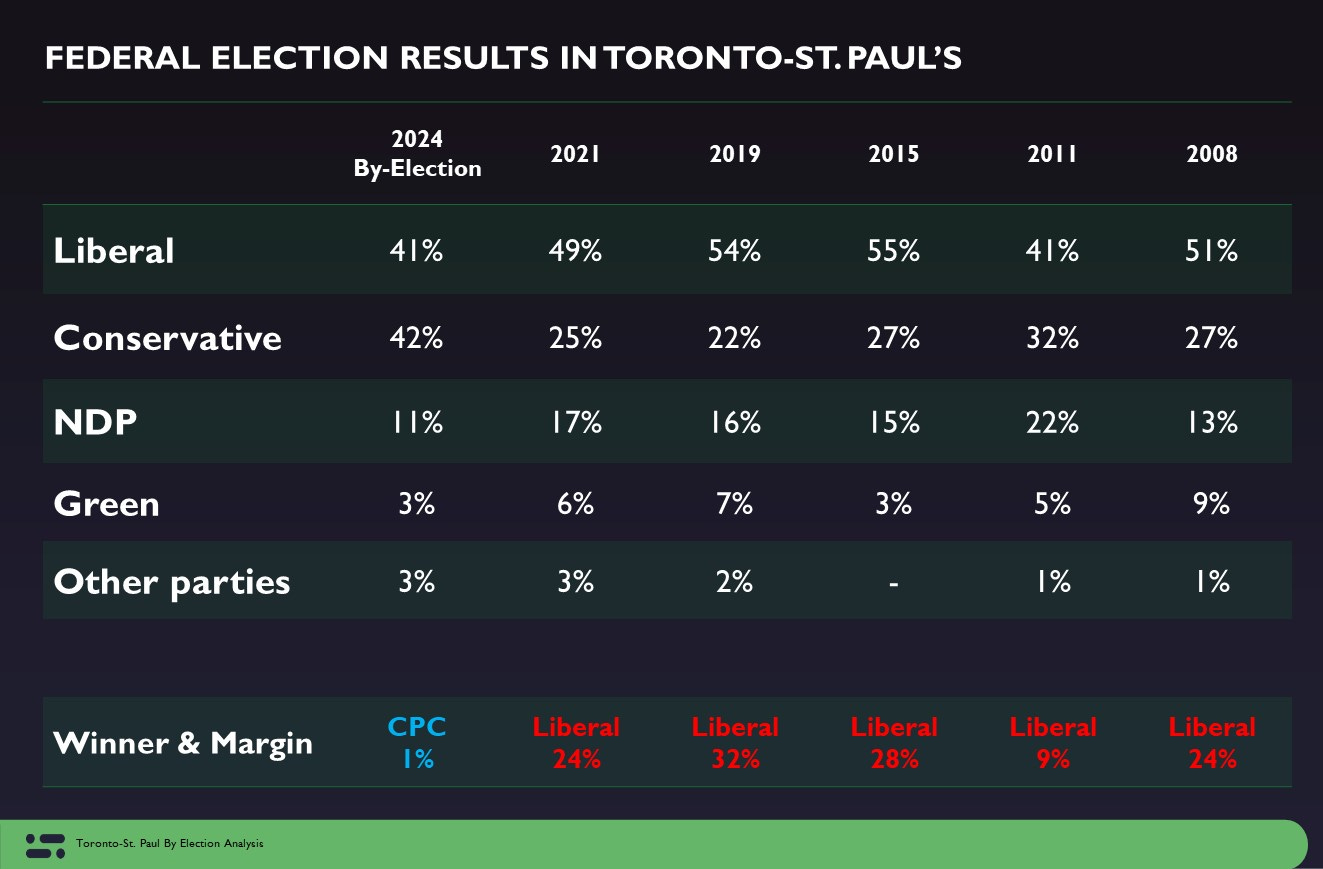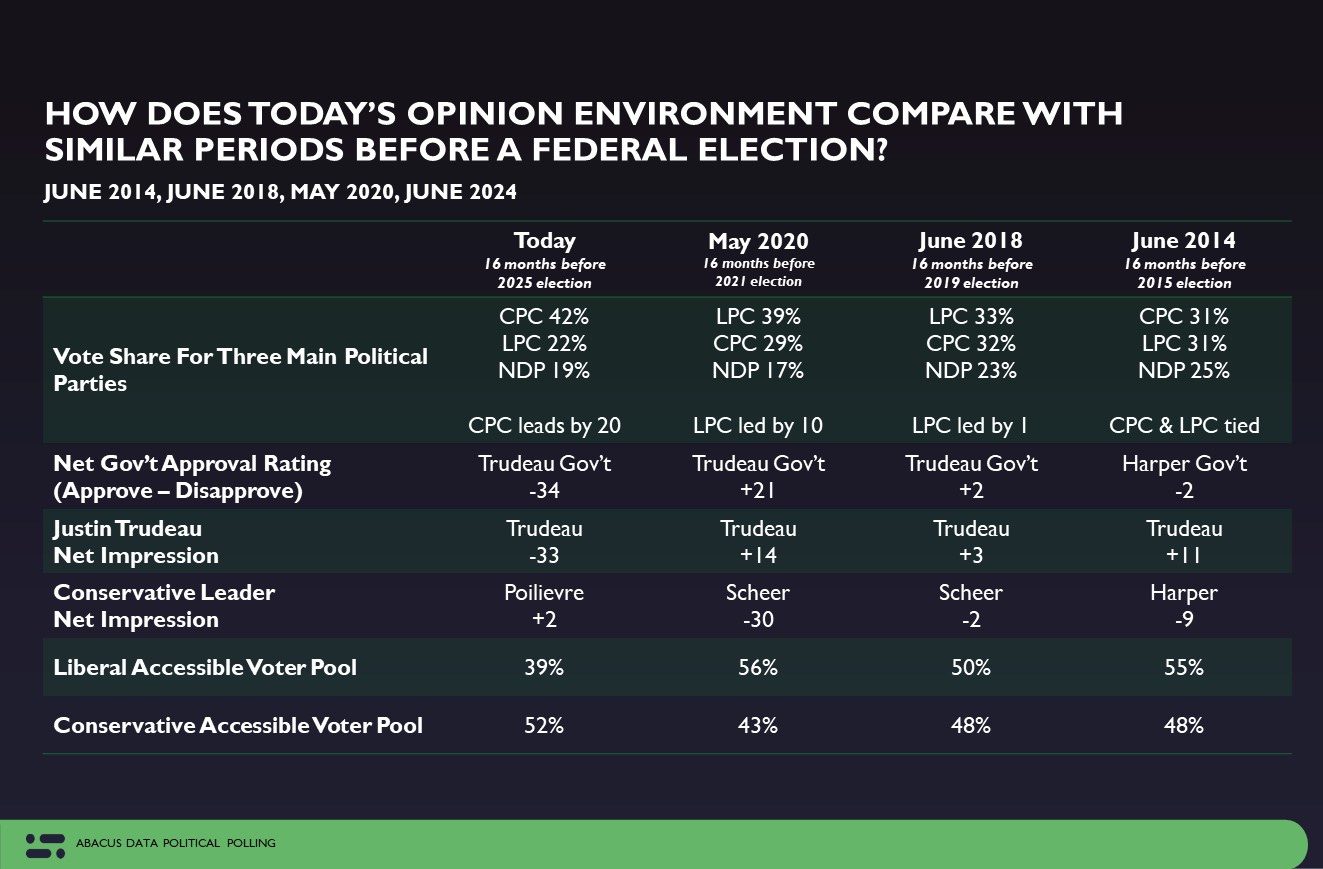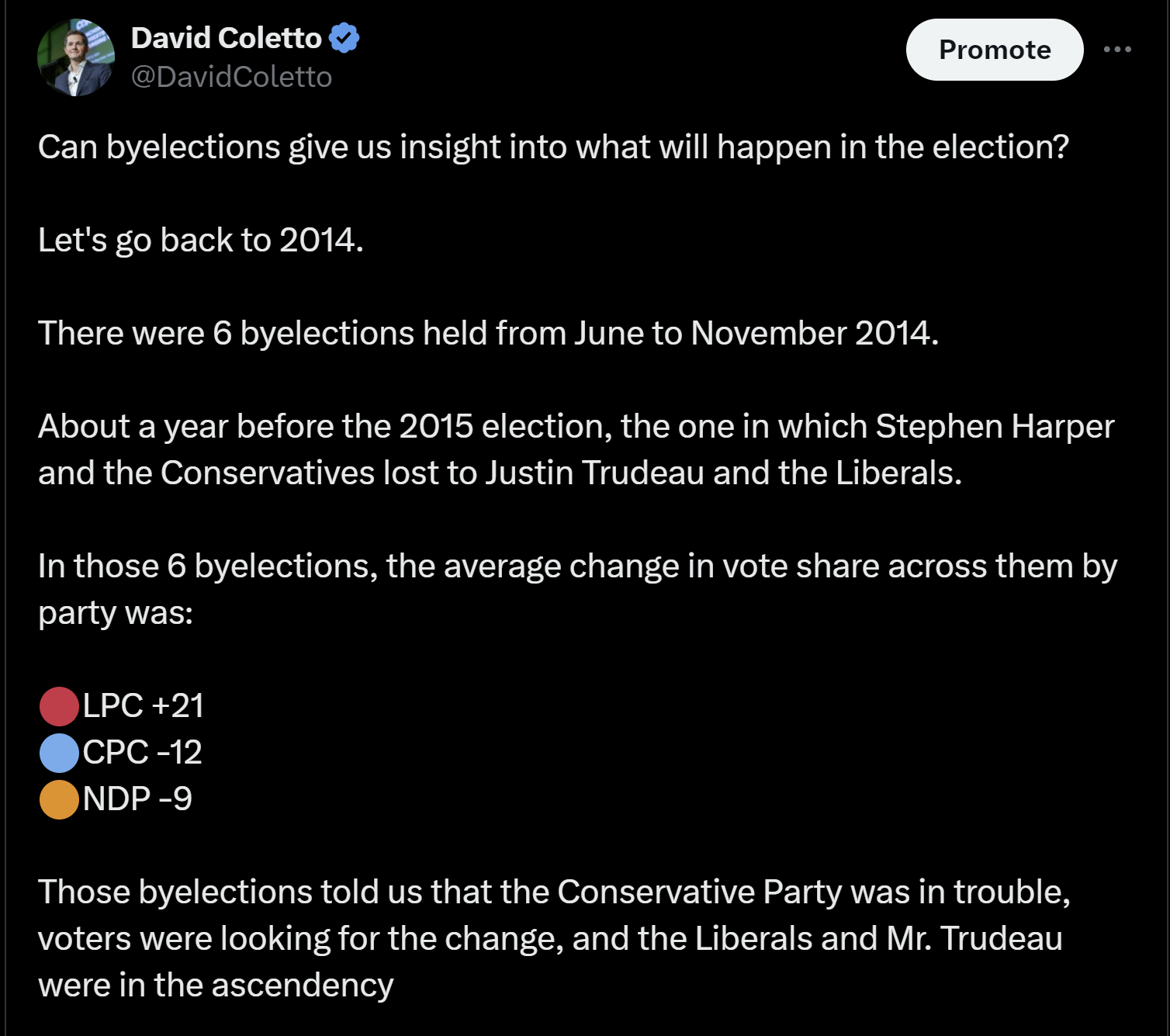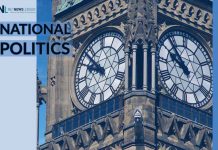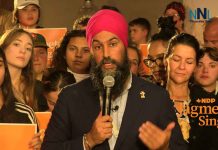Toronto-St. Paul’s Byelection: A Swing Big Enough to Wipe Out 55 Liberal Seats in Ontario
This post was written by David Coletto with swing calculations provided by Eric Grenier from The Writ. Anyone who enjoys this newsletter will also love Eric’s. I encourage you to subscribe.
This was not any ordinary byelection. The stakes were high. I went to bed thinking the Liberals would hold on, but when I woke up, the Conservatives and Don Stewart won the riding by about 600 votes or a 2-point margin. Toronto-St. Paul’s was one of the safest Liberal seats.
We imagine many, if not most, Liberal MPs from Ontario and beyond were furiously refreshing the Elections Canada results page for the Toronto-St. Paul’s byelection after polls closed at 8:30pm. With every reload, the anxiety mounted as they watched as the results were reported in real-time.
It went something like this:
At 9:32pm, the Liberals lead by 5 votes (75 to 70).
At 9:53pm, the Liberal candidate expands the lead to 139 (616 to 477).
At 11:00pm, the approximate 500 vote lead for the Liberals is holding (2,703 to 2,178)
This was the point I went to bed, probably like many others (after the disappointing Oilers loss).
When I wake up, I see a notification on my phone, the votes had been counted and the Conservatives stun the political world by winning by it.
Those Liberal MPs, like other interested observers, are left wondering: Is what happened in Toronto-St. Paul’s going to happen in their ridings?
Toronto-St. Paul’s, a riding that has been a Liberal-held seat since 1993, has weathered many political storms for the Liberals. Even in 2011, when the Liberals were decimated in Ontario, securing only 11 seats, Toronto-St. Paul’s held firm with an 8-point margin. Fast forward to Monday’s byelection, and the winds seem to be shifting.
In this post, we explore the possible implications of the kind of swing seen in Toronto-St. Paul’s last night on other ridings across Ontario including the hypothetical results for some high-profile incumbents.
The Results in Toronto-St. Paul’s Last Night
The results last night are very different than anything we have seen in the riding over the past 30 years. The Conservative victory by a slim 1.6-point margin represents a 24.9 point swing. This is the worst result the Liberals have registered in this riding since the 1993 election in terms of vote share and margin.
For the last three elections, the long-time Liberal MP Carolyn Bennett has won by a margin of at least 24-points with her largest victory coming in 2019 when she defeated the Conservative candidate by 32-points. In 2011, when the Liberals held onto only 11 seats in Ontario after its worst performance in party history, the Liberals still won Toronto-St. Paul’s by 9-points.
What would happen if the swing in Toronto-St. Paul’s is replicated province-wide?
To assess the impact of such a big vote swing in Toronto-St. Paul’s, Eric used a simple uniform swing model and applied the swing from last night’s byelection to the 2021 results across Ontario, taking into account the new federal map that will be used in the next election.
Obviously there are some limits to this like the impact of incumbency (there was no incumbent in Toronto-St. Paul’s), and that the swing may not be uniform in all ridings. But this exercise does give us a sense of what would happen in Ontario if the same swing that occurred in Toronto-St. Paul’s happened across the province.
Based on the 2021 election results, the Liberals would have won 77 seats in Ontario under the new map.
The model suggests that a 25-point swing, like we saw last night in the byelection, would likely mean around 55 Liberal seats in Ontario would switch to the Conservatives.
The Liberals would lose the following seats:
- Aurora—Oak Ridges—Richmond Hill
- Brampton Centre
- Brampton East
- Brampton North—Caledon
- Brampton South
- Brampton—Chinguacousy Park
- Burlington
- Burlington North—Milton West
- Cambridge
- Don Valley North
- Eglinton—Lawrence
- Etobicoke Centre
- Etobicoke—Lakeshore
- Guelph
- Hamilton East—Stoney Creek
- Hamilton Mountain
- Hamilton West—Ancaster—Dundas
- Kanata
- Kingston and the Islands
- Kitchener South—Hespeler
- Kitchener—Conestoga
- London Centre
- London West
- Markham—Stouffville
- Markham—Unionville
- Milton East—Halton Hills
- South Mississauga Centre
- Mississauga East—Cooksville
- Mississauga—Erin Mills
- Mississauga—Lakeshore
- Mississauga—Malton
- Mississauga—Streetsville
- Nepean
- Newmarket—Aurora
- Nipissing—Timiskaming
- Oakville East
- Oakville West
- Orléans
- Ottawa South
- Ottawa West—Nepean
- Pickering—Brooklin
- Prescott—Russell—Cumberland
- Richmond Hill South
- St. Catharines
- Sudbury
- Sudbury East—Manitoulin—Nickel Belt
- Thunder Bay—Rainy River
- Thunder Bay—Superior North
- Toronto—St. Paul’s
- Vaughan—Woodbridge
- Waterloo
- Whitby
- Willowdale
- Windsor—Tecumseh—Lakeshore
- York Centre
In short, the vote swing was big enough that all but a handful of Liberal MPs would likely have held onto their seat if the same shift happened in their ridings and that not taking into account which seats the NDP may pick up in downtown Toronto.
The Upshot
Last night’s results will send shockwaves through Canadian politics. The Conservatives outperformed the polls and the swing was substantial and big enough that if replicated across Ontario, would lead to the Liberals losing 55 seats and holding onto only 5 to 6 seats.
This would fewer than the party’s worst electoral performance in the 2011 federal election when it won only 11 seats in Ontario and 34 nationally.
And when we look at the polling and compare it to the last three federal elections 16-months out from an election, it confirms how voters behaved in Toronto-St. Paul’s last night.
Will Trudeau stay or go? Let’s see how he, MPs, and others respond today. But as to the question of whether voters want him to or not became even more clear.
And to those who say byelections don’t matter or reflect the future, I offer up this: https://x.com/DavidColetto/status/1805409061468242233



